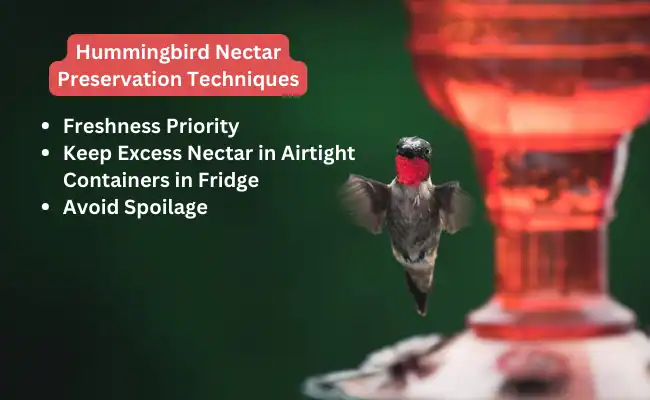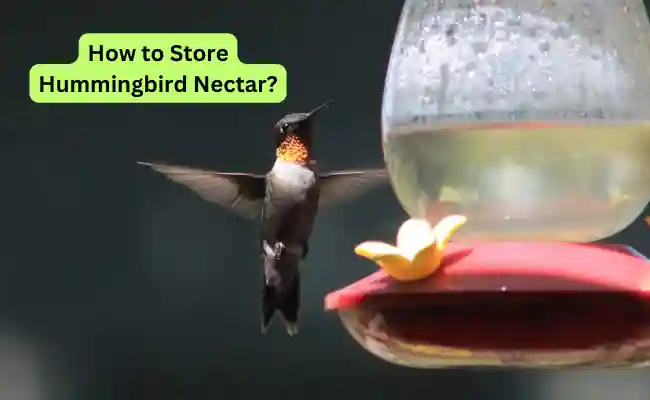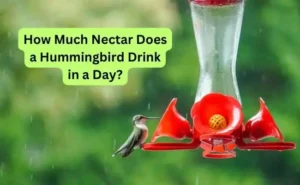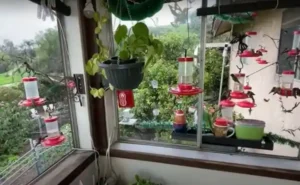Want more hummingbirds in your garden? How about keeping them coming back for more?
Storing hummingbird nectar is the key. Nectar is the main source of energy for hummingbirds because it gives them carbs. A whole lot of people choose store-bought nectar to feed hummingbirds, although it is not a bad choice either, it is less recommended.
But you can’t deny that making your own at home can be fun and save you money. Here’s the kicker, what would you do with the leftover nectar? No worries because I am here to help you out. Let’s look into the nitty-gritty of keeping that nectar fresh and feast-worthy for our little feathered friends.
But hey, hold on First off, let’s address the elephant in the room or, should I say, the hummingbird in the garden. You might think, “Hey, I’ll just pop this extra nectar into the fridge. Problem solved, right?” Not so fast.
As a seasoned wildlife biologist and a self-confessed hummingbird nut, I’ve learned the hard way that these little birds are more discerning diners than you’d usually think.
Fresh is Always the Best
More fresh, More better! This is so true for hummingbird nectar. Fresh nectar is essential for our little friends as it provides them with more energy they need to zip around like tiny, colorful rockets.
Remember, hummingbirds have been perfecting their sense of taste for thousands of years. They’re not about to sip on yesterday’s leftovers that have seen better days. After much trial and error, I’ve found that mixing small batches of nectar ensures that my feathery patrons always get the freshest fare.
By giving fresh nectar in clean feeders to our little jewels, we can not only attract a large number of hummingbirds to our garden but it can also ensure that they have a healthy and tasty treat waiting for them.
Cool, Not Cold
Storing your hummingbird nectar in the fridge seems like a no-brainer, right? Well, here’s the twist: cold storage isn’t the cure-all we’d hope for. Even in the chilliest corner of your fridge, sugar water can become a playground for bacteria and mold within 24 hours.
Trust me, your hummingbirds won’t thank you for a side of microbes with their meal. Generally, temperatures between 30-37 degrees Fahrenheit are considered too cold for hummingbird nectar. Hummingbirds do not prefer very cold nectar as it can cold-stun them.

Hummingbird Nectar Preservation Techniques
Do you have a deep-seated passion for little hummingbirds and are curious about the most effective way to store the nectar you make at home? There is no need to look any further!
One of the most reliable ways I’ve found is to simply prepare what you’ll require for 1-2 days. By doing this, not only will the nectar continue to be fresh and attractive for our fluttering friends, but you will also avoid the disappointment of discovering that a science project is brewing in your refrigerator.
But let’s just say that you’ve overestimated your guests’ appetite and mixed a bit too much of the nectar. Now, you are torn between storing or discarding the nectar that you have prepared with love.
My suggestion is that you absolutely must store the excess nectar, and keep it in a clean, airtight container in the fridge. Now, you might be thinking about how long will hummingbird nectar last in the refrigerator, make a mental note to use refrigerated nectar within 24 hours. Beyond that, you’re better off starting from scratch.
How to Make Nectar at Home?
It’s easy to make your hummingbird nectar, and you can be sure that the items are of high quality. Here are the steps you need to take to make your hummingbird nectar;
- First of all, start by boiling the water on a low flame, making sure that the water is fresh and clean. If your tap water has a lot of chemicals, strong flavors, or smells, it’s a good idea to use bottled or purified water for making clean nectar. One part sugar to four parts water is what you need for each batch of nectar. I.e., you will need 1/2 cup of sugar and 2 cups of water to make 2 cups of nectar.
- As soon as the water starts to boil, add the sugar and mix it in well. It’s crucial to use white powdered sugar because it’s very similar to the sugar that flowers naturally produce. Keep in mind that even if you don’t want to feed hummingbirds white sugar, don’t use brown sugar, powdered sugar, or any other substitutes.
- Before putting food in your hummingbird feeder, let the mixture cool down. Before putting the nectar in the feeder, it’s important to make sure it’s at room temperature so that it doesn’t hurt the hummingbirds or the feeder.
- Put the home-made nectar in your hummingbird feeder. Before you fill up the feeder again, make sure to clean it well to stop dangerous bacteria or mold from growing in the feeder.
How Long Does Store-Bought Hummingbird Nectar Last?
When you buy hummingbird nectar from the store, you might wonder how long it stays good. This shelf life question pops up like a jack-in-the-box. Here’s the scoop: unopened, store-bought nectar can last quite a while, often until the expiration date printed on the package. But once that seal is broken, it’s a different ball game.
You’ve got about a week to play, provided you keep it refrigerated. Think of it as milk for your feathered friends – you wouldn’t drink sour milk, and they won’t appreciate outdated nectar. So, keep an eye on that calendar and refresh your feeders with fresh nectar regularly. It’s like keeping the party snacks fresh; nobody likes stale chips, especially not your hummingbird guests.
Is Store-Bought Hummingbird Nectar Safe?
Now, onto the million-dollar question: is rolling out the red carpet with store-bought nectar safe for our tiny, buzzing guests? In a nutshell, yes, but with a caveat. Most store-bought nectar is generally safe and prepared with hummingbirds’ health in mind. However, the devil is in the details or in this case, the ingredients.
Look for nectar that’s free from dyes and preservatives. Your goal is to mimic the natural diet of these birds as closely as possible, not to turn their feeding time into a chemical cocktail hour. Remember, what’s on the menu directly impacts their health. Opting for simple, natural options is like choosing a home-cooked meal over fast food – it’s a choice that speaks of care and consideration for your aerial visitors.
Final Words – How to Store Hummingbird Nectar?
In my years of hummingbird hospitality, I’ve learned that these birds are the ultimate critics. They know what they like, and they won’t settle for second best. By ensuring your nectar is as fresh as possible, you’re not just feeding hummingbirds; you’re inviting them to a gourmet dining experience in your backyard.
And let’s be honest, is there anything more delightful than watching a hummingbird hover mid-air as it sips on the nectar you’ve lovingly prepared? It’s a small way to connect with nature, but it’s also a reminder of the simple joys that life has to offer.
So, mix up that nectar, keep it fresh, and get ready for the show. Your backyard is about to become the hottest spot in town for the hummingbird happy hour.



